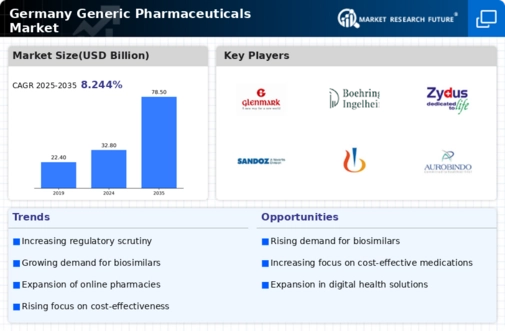Aging Population
Germany's demographic shift towards an aging population is a crucial driver for the generic pharmaceuticals market. By 2025, it is projected that over 22% of the German population will be aged 65 and older. This demographic is typically associated with increased healthcare needs, including chronic disease management and long-term medication use. As older adults often require multiple prescriptions, the demand for affordable generic alternatives becomes paramount. The generic pharmaceuticals market stands to benefit from this trend, as healthcare providers and patients alike seek to minimize costs while ensuring access to necessary medications, thus enhancing the overall sustainability of the healthcare system.
Rising Chronic Diseases
The prevalence of chronic diseases in Germany significantly influences the generic pharmaceuticals market. Conditions such as diabetes, hypertension, and cardiovascular diseases are on the rise, necessitating long-term medication regimens. In 2025, it is estimated that nearly 30% of the German population will be living with at least one chronic condition. This trend creates a sustained demand for affordable medication options, as patients seek to manage their health without incurring exorbitant costs. The generic pharmaceuticals market is well-positioned to meet this demand, providing essential medications that help improve patient outcomes while maintaining cost-effectiveness.
Increasing Healthcare Costs
The rising costs associated with healthcare in Germany are driving the demand for the generic pharmaceuticals market. As patients and healthcare providers seek to manage expenses, generic medications offer a more affordable alternative to branded drugs. In 2025, it is estimated that healthcare spending in Germany will reach approximately €500 billion, with a significant portion allocated to pharmaceuticals. This financial pressure encourages the adoption of generics, which can be up to 80% cheaper than their branded counterparts. Consequently, the generic pharmaceuticals market is likely to experience growth as more patients opt for cost-effective solutions, thereby alleviating some of the financial burdens on the healthcare system.
Increased Awareness of Generic Options
There is a growing awareness among healthcare professionals and patients regarding the benefits of generic medications in Germany. Educational campaigns and initiatives by health authorities have contributed to a shift in perception, highlighting the efficacy and safety of generics. As of 2025, surveys indicate that approximately 70% of patients are aware of generic alternatives, leading to increased acceptance and utilization. This heightened awareness is likely to bolster the generic pharmaceuticals market, as more individuals opt for generics over branded drugs, thereby promoting a more sustainable healthcare landscape.
Government Initiatives for Cost Control
The German government has implemented various initiatives aimed at controlling healthcare costs, which significantly impacts the generic pharmaceuticals market. Policies such as the AMNOG (Act on the Reform of the Market for Medicinal Products) encourage the use of generics by promoting price negotiations and reimbursement strategies that favor lower-cost alternatives. In 2025, these initiatives are expected to result in a 15% increase in the market share of generics within the overall pharmaceutical sector. By incentivizing healthcare providers to prescribe generics, the government is fostering a more competitive environment that benefits both patients and the healthcare system.
























Leave a Comment